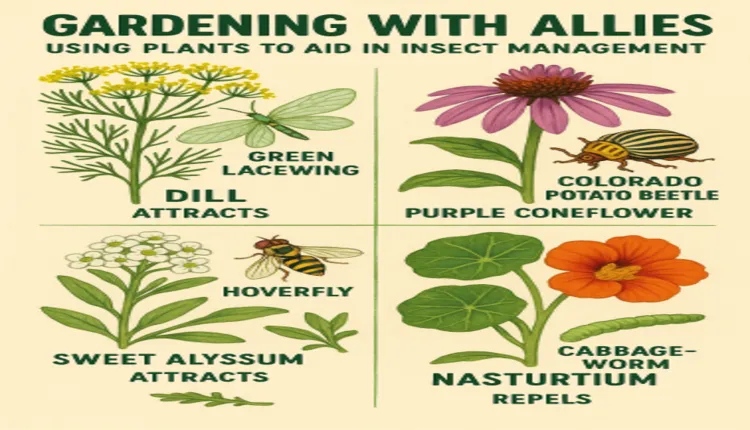Gardening with allies: using plants to aid in insect management
Discover how companion planting and beneficial insects can naturally manage pests and promote a healthy, thriving garden ecosystem.

Gardening is more than just cultivating plants; it's about fostering a balanced ecosystem where plants and insects coexist harmoniously. By strategically selecting and placing certain plants, gardeners can naturally manage pests, reducing the need for chemical interventions. This approach, known as companion planting, leverages the natural relationships between plants and insects to create a thriving, self-sustaining garden.
Understanding Beneficial Insects
Beneficial insects are nature's pest control agents. They prey on harmful pests, keeping their populations in check. Some common beneficial insects include:
- Ladybugs: Known for their appetite for aphids, they also consume mites and other soft-bodied insects.
- Praying Mantises: These predators feed on a variety of pests, including caterpillars and beetles.
- Parasitic Wasps: They lay their eggs inside pest insects, effectively controlling populations of caterpillars and aphids.
- Ground Beetles: These nocturnal hunters feed on slugs, snails, and other soil-dwelling pests.
- Hoverflies: Their larvae consume aphids, while adults pollinate flowers.
To attract and retain these beneficial insects, it's essential to provide them with food (nectar and pollen), water, and shelter. Planting a variety of flowering plants that bloom at different times ensures a continuous food source. Additionally, providing shallow water sources and maintaining permanent plantings like shrubs and perennials offer shelter and breeding grounds.
How Plants Aid in Insect Management
Plants assist in pest control through:
- Aromatic Repellents: Certain plants emit scents that deter pests. For instance, marigolds release compounds that repel aphids and nematodes.
- Attracting Predators and Parasitoids: Plants like dill and fennel attract beneficial insects that prey on pests.
- Visual Distraction: A diverse garden with varying plant heights, colors, and textures can confuse pests, making it harder for them to locate their preferred hosts.
Incorporating Insectary Plants
Insectary plants are specifically grown to attract and support beneficial insects. By ensuring a succession of blooms from early spring to late fall, gardeners can provide a continuous food source. Some effective insectary plants include:
- Yarrow: Attracts ladybugs and hoverflies.
- Sweet Alyssum: Draws in predatory wasps and hoverflies.
- Lavender: Lures pollinators and repels moths.
- Sunflowers: Provide nectar for bees and shelter for predatory insects.
Integrating these plants into your garden not only aids in pest control but also enhances biodiversity.
Practical Tips for Gardeners
- Diverse Planting: Cultivate a mix of plants to attract a variety of beneficial insects.
- Continuous Bloom: Ensure that at least one plant is in bloom throughout the growing season.
- Provide Water: Place shallow dishes with water and pebbles to offer hydration for insects.
- Avoid Pesticides: Chemical sprays can harm beneficial insects. Opt for organic methods when possible.
- Maintain Shelter: Leave some areas undisturbed or plant perennials to offer overwintering sites.
By embracing the principles of companion planting and fostering an environment conducive to beneficial insects, gardeners can achieve a natural balance, leading to healthier plants and reduced pest issues. This holistic approach not only benefits the garden but also supports the broader ecosystem.













